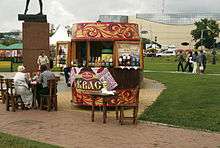Kvass
Kvass is a traditional fermented Slavic and Baltic beverage commonly made from rye bread, which is known in many Central and Eastern European and Asian[1][2] countries as "black bread". The colour of the bread used contributes to the colour of the resulting drink. Kvass is classified as a "non-alcoholic" drink by Ukrainian, Belarusian, Russian, Latvian, Lithuanian, Polish, Hungarian, Serbian, and Romanian standards, as the alcohol content from fermentation is typically low (0.5–1.0% or 1–2 proof).[3] It may be flavoured with fruits such as strawberries or raisins, or with herbs such as mint.[4] Kvass is especially popular in Russia.[5][6][7]
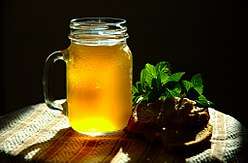 A mug of kvass | |
| Alternative names | Квас, хлібний квас, kwas chlebowy (bread kvass), kvas, kvasz, kawas, cvas, gira, kali |
|---|---|
| Type | Fermented non-alcoholic drink, sometimes of very low alcohol content - occasionally higher |
| Course | Beverage |
| Region or state | Central and Eastern Europe, Baltic states, North Caucasus, Post-Soviet states, Xinjiang, Heilongjiang |
| Created by | East Slavs |
| Serving temperature | Cold or room temperature |
| Main ingredients | Rye bread, water, yeast, sometimes flavoured with fruit, raisins, honey |
| Variations | Flavoured with fruit |
| Circa 30–100 kcal | |
Terminology
The word kvass is derived from Old Church Slavonic квасъ from Proto-Slavic *kvasъ ('leaven', 'fermented drink'). The modern Russian word квасить (kwasit) means "to acidify" and "to sour". It is ultimately from Proto-Indo-European base *kwat- ('sour').[8][9][10] Today the words used are almost the same: in Belarusian: квас, kvas; Russian: квас, kvas; Ukrainian: квас/хлібний квас/сирівець, kvas/khlibny kvas/syrivets; in Polish: kwas chlebowy ('bread kvass', the adjective being used to differentiate it from kwas, 'acid', originally from kwaśne, 'sour'); Latvian: kvass; Romanian: cvas; Hungarian: kvasz; Serbian: kвас; Chinese: 格瓦斯/克瓦斯, géwǎsī/kèwǎsī. Non-cognates include Lithuanian gira ('beverage', similar to Latvian dzira), Estonian kali, and Finnish kalja.
Manufacturing
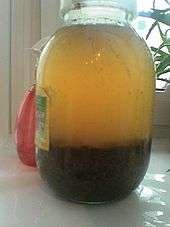
Kvass is made by the natural fermentation of bread, such as wheat, rye, or barley, and sometimes flavoured using fruit, berries, raisins, or birch sap.[11] Modern homemade kvass most often uses black or regular rye bread, usually dried (called plural suhari), baked into croutons, or fried, with the addition of sugar or fruit (e.g. apples or raisins), and with a yeast culture and zakvaska ("kvass fermentation starter").[12][13]
Traditional kvass was generally manufactured by mixing several kinds of malt (rye malt was preferred, but barley and wheat malts were also used, giving a somewhat different taste to the resulting drink) with flour and/or breadcrumbs and diluting them with boiling water to a paste-like consistency. This dough was then subjected to the moderate (and diminished) heat for several hours, for example by putting the vessel into a cooling Russian stove, or covering it with a blanket, so that malt enzymes could work on the starches in the flour and breadcrumbs. After the heat treatment, the malted mash was further diluted with the warm water, the yeast and flavorings added, and the resulting wort was fermented several days in a warm place, after which it was lautered, with the liquid portion — the finished kvass — packaged and sold, and lees used as a concentrate/fermentation starter for the next batches, which simply used some lees, additional flour and more water, without adding more yeast or the time-consuming mashing process. Because wort is never boiled, it contains not only yeasts, but also a large amount of other microorganisms, including those responsible for the lactic fermentation, which is the chief difference distinguishing kvass from the traditional beer.
History
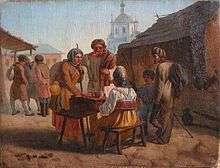
Kvass originated at the time of ancient Rus' and was a common drink in Old Russian Muscovite state.[14] It has been a common drink in Russia and other Eastern European countries since at least the Middle Ages. The drink is comparable to some other ancient fermented grain beverages including beer brewed from barley by the ancient Egyptians, the pombe or millet beer of Africa, the so-called rice wines of Asia, the chicha made with corn or cassava by the natives of the Americas.[15] Kvass was invented by the Slavs and became the most popular among East Slavs.[16]
The word "kvass" was first mentioned in the Primary Chronicle, in the description of events of the year 996, following the Christianization of the Kievan Rus'.[17] According to the Merriam-Webster Dictionary and Oxford English Dictionary the first mention of kvass in an English text took place sometime around 1553.[18][19] In times of Old Russia kvass developed into a national drink and was consumed by all classes. The peak of its popularity was the 15th and 16th centuries, where every Russian on average drank 200 to 250 liters of Kvass per year, from the poor to the Tsars. Already back then there existed many different kvass varieties: red, white, sweet, sour, mint, honey, berry and so on, with many different local variations.
In Russia, under Peter the Great, it was the most common non-alcoholic drink in every class of society. William Tooke, describing Russian drinking habits in 1799, stated that "The most common domestic drink is quas, a liquor prepared from pollard, meal, and bread, or from meal and malt, by an acid fermentation. It is cooling and well-tasted."[20]
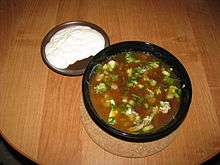
Apart from drinking kvass, families (especially the poor ones) used it as the basis of many dishes they consumed.[16] Traditional cold summertime soups of Russian cuisine, such as okroshka,[4] botvinya and tyurya, are based on kvas. A similar tradition is found in Romanian cuisine,[21] where the liquid used for cooking is made by fermenting wheat or barley bran and called borș.
Kvass was reported to be consumed in excess by peasants, low-class citizens, and monks; in fact, it is sometimes said that it was usual for them to drink more kvass than water. In the 19th century, the kvass industry was created and less natural versions of the drink became increasingly widespread.[16] On the other hand, the popularity of kvass and the market competition led to the emergence of many varieties, which included herbs, fruits and berries. At that time kvass vendors called kvasnik (pl. kvasniki) were on the streets in almost every city. They often specialised in particular kinds of kvass: strawberry kvass, apple kvass, etc.[22][23]
Nowadays, kvass production is a multimillion-dollar industry, though it has been struggling ever since the introduction of Western soft drinks in Eastern European countries. Kvass was once sold during the summer only, but is now produced, packaged, and sold year-round.[24]
Modern Russia
Although the massive flood of western soft drinks after the fall of the USSR such as Coca-Cola and Pepsi substantially shrank the market share of kvass in Russia, in recent years it has regained its original popularity, often marketed as a national soft drink or "patriotic" alternative to cola. For example, the Russian company Nikola (by coincidence its name sounds like "not-cola" in Russian) has promoted its brand of kvass with an advertising campaign emphasizing "anti cola-nisation." Moscow-based Business Analytica reported in 2008 that bottled kvass sales had tripled since 2005 and estimated that per-capita consumption of kvass in Russia would reach three liters in 2008. Between 2005 and 2007, cola's share of the Moscow soft drink market fell from 37% to 32%. Meanwhile, kvass' share more than doubled over the same time period, reaching 16% in 2007. In response, Coca-Cola launched its own brand of kvass in May 2008. This is the first time a foreign company has made an appreciable entrance into the Russian kvass market. Pepsi has also signed an agreement with a Russian kvass manufacturer to act as a distribution agent. The development of new technologies for storage and distribution, and heavy advertising, have contributed to this surge in popularity; three new major brands have been introduced since 2004.[24] Kvass is produced in Russia in different flavors, matched to the taste of the different regions of Russia that prefer sweet kvass or the more sour variety. There are existing various versions of kvass, like for example red bilberry and cranberry.
Market shares (2014)
| Company (brand) | Share [%][25] |
|---|---|
| Deka/NiCola ("Никола") | 39 |
| Ochakovskiy ("Очаковский") | 18.9 |
| PepsiCo («Русский дар») | 11.6 |
| Carlsberg Group («Хлебный край») | 5.5 |
| Coca-Cola, Inc. («Кружка и бочка») | 2.1 |
| Other | 22.9 |
Poland
.jpg)
Kvass may have appeared in Poland as early as the 10th century mainly due to the trade between the Kingdom of Poland and Kievan Rus', where it originated.[26] The production of kvass went on for several hundred years, as recipes were passed down from parent to offspring. This continued in the Polish–Lithuanian Commonwealth. It was at first commonly drunk among peasants who worked on the fields in the eastern parts of the country. This eventually spread to the szlachta (Polish nobility). One example of this is kwas chlebowy sapieżyński kodeński, an old type of Polish kvass that is still sold as a contemporary brand.[27] Its origins can be traced back to the 1500s, when Jan Sapieha – a magnate of the House of Sapieha – was granted land by the Polish king. On those lands he founded the town of Kodeń. He then bought the mills and 24 villages of the surrounding areas from their previous landowners.[27] It was then that the taste of kvass became known among the Polish szlachta, who used it for its supposed healing qualities.[27] After the last Partition of the Polish–Lithuanian Commonwealth in 1795, Poland ceased to be an independent state for 123 years. Throughout the 19th century, kvass remained popular among Poles who lived in the Congress Poland of Imperial Russia and in Austrian Galicia, especially the inhabitants of rural areas.[27]
Production of the beverage in Poland on an industrial scale can be traced back to the more recent interwar period, when the Polish state regained independence as the Second Polish Republic. In interwar Poland, kvass was brewed and sold in mass numbers by magnates of the Polish drinks market like the Varsovian brewery Haberbusch i Schiele or the Karpiński company.[28] Kvass was remained popular in eastern Poland,[29] partly due to the plentiful numbers of Belarusian and Ukrainian minorities that lived there. However, with the collapse of many prewar businesses and much of the Polish industry during World War II, kvass lost popularity following the aftermath of the war. It also lost favour upon the introduction of Coca-Cola onto the Polish market.
Although not as popular in Poland nowadays as it is in neighbouring Ukraine, kvass can still be found in some supermarkets and grocery stores where it is known in Polish as kwas chlebowy ([kvas xlɛbɔvɨ]). Commercial bottled versions of the drink are the most common variant, as there are companies that specialise in manufacturing a more modern version of the drink (some variants are manufactured in Poland whilst others are imported from its neighbouring countries, Lithuania and Ukraine being the most popular source).[30] However, recipes for a traditional version of kvass exist; some of them originate from eastern Poland.[31][32] Although commercial kvass is much easier to find in Polish shops, Polish manufacturers of more natural and healthier variants of kvass have become increasingly popular both within and outside of the country's borders.[33]
Belarus

Belarus has a variety of kvass tasting and entertainment festivals.[34] The largest show takes place in the city of Lida.[35] Belarus has a handful of kvass breweries,[36] among which: Alivaria, the Olvi plc subsidiary Lidskae,[37][38][39] Khatni, the Brest Regional Executive Committee owned Brestskoye Pivo JSC,[40] and Krinitsa, which is an arm of the state-owned enterprise Belgospischeprom.[41] Khatni, which is brewed by the Oasis Group in partnership with Heineken, stresses that they ferment "according to the traditional recipe only using natural ingredients without colouring and flavouring agents."[42] Alivaria and Lidskae are also well-known beer breweries in Belarus with years of tradition and a visible presence on the Belarusian alcoholic beverages market.
Latvia and Lithuania
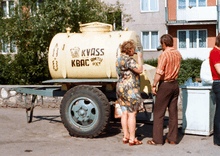
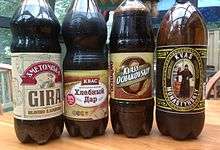
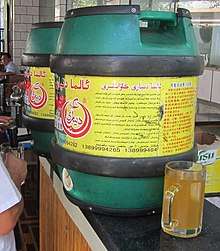
After the dissolution of the Soviet Union in 1991, the street vendors disappeared from the streets of Latvia due to new health laws that banned its sale on the street. Economic disruptions forced many kvass factories to close. The Coca-Cola Company moved in and quickly dominated the market for soft drinks. In 1998 the local soft drink industry adapted by selling bottled kvass and launching aggressive marketing campaigns. This surge in sales was stimulated by the fact that kvass sold for about half the price of Coca-Cola. In just three years, kvass constituted as much as 30% of the soft drink market in Latvia, while the market share of Coca-Cola fell from 65% to 44%. The Coca-Cola company had losses in Latvia of about $1 million in 1999 and 2000. The situation was similar in the other Baltic countries and Russia. Coca-Cola responded by buying kvass manufacturers as well as making kvass at their own soft drink plants.[43][44][45][46]
In Lithuania, kvass is known as gira and is widely available in bottles and draft. Many restaurants in Vilnius make their own gira, which they sell on the premises. Strictly speaking, gira can be made from anything fermentable—such as caraway tea, beetroot juice, or berries—but it is made mainly from black bread, or from barley or rye malt.
Elsewhere
In the United Kingdom, kvass is practically unknown, as there are no cultural ties to it within the nation's history and there are no renowned kvass breweries in the country. However, with the influx of immigrants following the 2004 enlargement of the European Union, a number of stores selling cuisine and beverages from Eastern Europe cropped up throughout the UK, many of them stocking kvass on their shelves.[47] In recent years, kvass has also become more popular in Serbia.[48]
In Norway kvass has traditionally been brewed by locals in Troms og Finnmark, the county closest to Russia. The influx of Eastern European migrant workers lead to a rise in demand of their native cuisines. This led Norwegian food-companies to start producing, among other products, kvass.
Cultural references
Kvas is a surname in Russia and some other countries.[49]
The name of Kvasir, a wise being in Norse mythology, is possibly related to kvass.[50][51][52][53][54]
The Russian expression "Перебиваться с хлеба на квас" (literally "to clamber from bread to kvass") means to barely make ends meet, remotely similar to (and may be translated as) the expression "to be on the breadline".[55] To better understand the Russian phrase one has to know that in poor families kvass was made from stale leftovers of rye bread.[56]
In the Polish language, there is an old folk rhyming song. It shows the history of kvass in the country as having been drunk by generations of Polish reapers as a thirst-quenching beverage used during periods of hard work during the harvest season, long before it became popular as a medicinal drink among the szlachta. The words of the song go as following:[57]
| Original Polish lyrics |
|---|
Od dawien dawna słynie napój zdrowy: |
| English translation |
|---|
A healthy drink has long been renowned: |
In Tolstoy's War and Peace, French soldiers are aware of kvass on entering Moscow, enjoying it but referring to it as "pig's lemonade".[58]
In Sholem Aleichem's Motl, Peysi the Cantor's Son, diluted kvass is the focus of one of Motl's older brother's get-rich-quick schemes.[59]
Similar beverages
Other beverages from around the world that are traditionally low-alcohol and lacto-fermented include:
References
- Bradley, Mayhew (2001). Mongolia (3rd ed.). Footscray, Vic.: Lonely Planet. p. 165. ISBN 1-86450064-6. OCLC 48591433.
- "Asian American: Chinese Thirst for Kvass Draws Wahaha into Russian Niche". Goldsea. Retrieved 2019-02-27.
- Ian Spencer Hornsey. A history of beer and brewing, p. 8. Royal Society of Chemistry, 2003. "A similar, low alcohol (0.5–1.0%) drink, kvass… may be a 'fossil beer'".
- Katz, Sandor (2003). Wild Fermentation. White River Junction, VA: Chelsea Green. p. 121. ISBN 1-931498-23-7.
- Baxter, Dudley; Magkoeva, Isabelle (2016-03-15). "This 1,000-Year-Old Bread Drink Is Becoming More Popular Than Beer in Russia". Vice. Retrieved 2019-07-06.
- "Kvas – more popular in Russia than Coca Cola". RNZ. 2018-06-25. Retrieved 2019-07-06.
- Pokhlebkin, Pokhlebkin, Vasilʹevich, William (1991). A History of Vodka. Russia, United Kingdom: Verso. p. 14. ISBN 0860913597.
- "Palaeolexicon - The Proto-Indo-European word *kwat-". www.palaeolexicon.com. Retrieved 17 October 2018.
- Max Vasmer. Russisches etymologisches Wörterbuch. Winter, Heidelberg, 1953–1958 (in German). Russian translation by Oleg Trubachyov: Этимологический словарь русского языка. Progress, Moscow, 1964–1973. квас
- Олег Николааевич Трубачёв и др. Этимологический словарь славянских языков. Академия наук СССР, Москва, т. 13 (1987), с. 153 (Oleg Trubachyov et al. Etymological dictionary of Slavic languages. USSR Academy of Sciences, Moscow, vol. 13 (1987), p. 153; in Russian)
- "How to Make Kvass". Practical Self Reliance. 12 April 2019.
- "Kvass bread beer, how to prepare it at home | Enjoy Food & Wine". enjoyfoodwine.com. 11 April 2018. Retrieved 2 June 2020.
- "Kvas – Russiapedia Of Russian origin". russiapedia.rt.com. Retrieved 2 June 2020.
- Ostrowski, Donald (2011). Portraits of Old Russia : Imagined Lives of Ordinary People, 1300-1745. Taylor and Francis. p. 273. ISBN 978-1-315-70161-5. OCLC 929511157.
- Anthropology, By Edward B. Taylor, page 268.
- Kwas chlebowy – Tradycja, pochodzenie oraz historia produktu: Archived 2017-12-01 at the Wayback Machine Kvass – Tradition, origin and history of the product. (in Polish)
- The Russian Primary Chronicle, Laurentian Text Archived October 16, 2013, at the Wayback Machine, p.121. Translated and edited by Samuel Hazzard Cross and Olgerd P. Sherbowitz-Wetzor. Cambridge, MA: The Medieval Academy of America, 1953.
- Kvass in Merriam Webster Dictionary
- Kvass in Oxford English Dictionary. c 1553 Chancelour Bk. Emp. Russia in Hakluyt Voy. (1886) III. 51 Their drinke is like our peny Ale, and is called Quass.
- Tooke, William (1799), View of the Russian empire during the reign of Catharine the Second, and to the close of the present century, Volume 1, Piccadilly: T.N. Longman and O. Rees, Pater-Noster-Row, and J. Debrett, p. 362
- Lucy, Mallows. Transylvania : the Bradt travel guide. Brummell, Paul,, Brummell, Adriana Mitsue Ivama (Third ed.). UK. ISBN 9781784770532. OCLC 1016263119.
- Что пили на Руси. Arguments and Facts (in Russian) (42). 2001.
- Квасные посиделки. Arguments and Facts (in Russian) (29). 2008.
- Russia's patriotic kvas drinkers say no to cola-nisation. The New Zealand Herald. BUSINESS; General. July 12, 2008.
- "Россия. Квас "Никола" стал маркой № 1 в продажах кваса по результатам летнего сезона". Пивное дело.
- Kwas chlebowy – przepis Kafeteria - kwas chlebowy. (in Polish)
- Kwas chlebowy sapieżyński kodeński – Tradycja, pochodzenie oraz historia produktu: Kwas chlebowy sapieżyński kodeński – Tradition, origin and history of the product. (in Polish)
- Alternatywa dla Coca Coli? Information regarding kvass in Interwar Poland.(in Polish)
- Broszura o naturalnym kwasie chlebowym Archived 2014-04-29 at the Wayback Machine Booklet about natural kvass. (in Polish)
- Gerima dystrybutor kwasu chlebowego w Polsce Gerima – distributor of kvass in Poland. (in Polish)
- Kwas chlebowy sapieżyński kodeński Information about traditional Polish kvass. (in Polish)
- Przepis na domowy kwas chlebowy Recipe for home-made kvass. (in Polish)
- Ich kwas chlebowy podbija rynek News article about Polish manufacturers of kvass made from traditional recipes.(in Polish)
- Webb, Tim; Beaumont, Stephen (2016). World Atlas of Beer: THE ESSENTIAL NEW GUIDE TO THE BEERS OF THE WORLD. Hachette UK. p. 148.
- "Drinks in Belarus". belarus.by.
- "Belorus beer increased exports" (in Polish). po.alcoruguru.ru. n.d. Retrieved 14 July 2020.
- "Olvi Group of Companies". lidskae.by.
- "Services / Sightseeings / Lida Brovar". vetliva.com.
- "Lida kvass". Belarusian touroperator PRPUE «Automated tourism technologies».
- "Main / About us / History of Development". brestbeer.by.
- "History of the Brewery".
- "Brands - Khatni".
- Lyons, J. Michael (January 13, 2002). "The real thing?: Coke cashes in by producing nostalgic, Soviet-era drink". Associated Press via SFGATE. Archived from the original on March 4, 2006. Retrieved September 27, 2006.
- "Legacy Mailer Back-Link Redirector Including News Item Anchor". www.latvians.com. Retrieved 17 October 2018.
- "Coca-Cola HBC – Products and Marketing". Archived from the original on 30 June 2007. Retrieved 17 October 2018.
- "Coca-Cola ups stake in Estonia". June 1, 2001.
- Polski sklep w Newcastle News article about a Polish shop in the North East of England.(in Polish)
- Bills, John William. "Here's What to Drink if You're Going to Serbia". Culture Trip. Retrieved 2019-07-06.
- "Kvas - Names Encyclopedia". www.namespedia.com. Retrieved 2018-09-24.
- Александр Николаевич Афанасьев (1865–1869). Поэтические воззрения славян на природу. Директ-медиа (2014) том. 1, стр. 260. ISBN 978-5-4458-9827-6 (Alexander Afanasyev. The Poetic Outlook of Slavs about Nature, 1865–1869; reprinted 2014, p. 260; in Russian)
- Karl Joseph Simrock. Handbuch der deutschen Mythologie mit Einschluss der nordischen, 1st edition (1855), p. 272 or 2nd edition (1864), p. 244. Bonn, Marcus.
- Jooseppi Julius Mikkola. Bidrag till belysning af slaviska lånord i nordiska språk. Arkiv för nordisk filologi, vol. 19 (1903), p. 331.
- Georges Dumézil (1974). Gods of the Ancient Northmen, p. 21. University of California Press. ISBN 978-0-520-03507-2
- Jan de Vries (2000). Altnordisches etymologisches Wörterbuch, p. 336. 4th edition, Leiden (in German)
- "перебиваться с хлеба на квас - IdiomCenter.com". idiomcenter.com.
- Svyatoslav Loginov, "We Used to Bake Blini..." ("Бывало пекли блины...") (in Russian)
- Śliwińska, Jolanta (29 June 2017). "Kwas chlebowy sapieżyński kodeński". Smakuj Lubelskie. Retrieved 22 December 2019.
- War and Peace. Leo Tolstoy. Book 10, chapter 29, Pennsylvania State University translation.
- Ronit Vered, "A Touch of Kvass", Haaretz (Nov 15, 2012); available online at https://www.haaretz.com/.premium-restaurants-a-touch-of-kvass-1.5198468
External links
| Look up kvass in Wiktionary, the free dictionary. |
